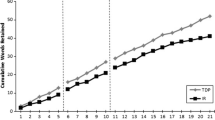Abstract
We compared the effectiveness and efficiency of a modified simple-conditional method and the conditional-only method for teaching receptive labeling of sight words. Jon, a 6-year-old boy diagnosed with autism spectrum disorder, participated. Across three comparative evaluations, the conditional-only method resulted in fewer sessions to mastery than a modified simple-conditional method. Textual responses emerged after Jon mastered the sight words as receptive labels. Practitioners should avoid teaching component simple discriminations as a strategy for facilitating conditional discrimination training in clinical practice.


Similar content being viewed by others
References
Fisher, W., Piazza, C., Bowman, L., & Amari, A. (1996). Integrating caregiver report with a systematic choice assessment to enhance reinforcer identification. American Journal on Mental Retardation, 10, 15–25.
Green, G. (2001). Behavior analytic instruction for learners with autism: advances in stimulus control technology. Focus on Autism and Other Developmental Disabilities, 16, 72–85. doi:10.1177/108835760101600203.
Grow, L. L., Carr, J. E., Kodak, T., Jostad, C. M., & Kisamore, A. N. (2011). A comparison of methods for teaching receptive labeling to children with autism spectrum disorders. Journal of Applied Behavior Analysis, 44, 475–498. doi:10.1901/jaba.2011.44-475.
Grow, L. L., Kodak, T., & Carr, J. E. (2014). A comparison of methods for teaching receptive labeling to children with autism spectrum disorders: a systematic replication. Journal of Applied Behavior Analysis, 47, 600–605. doi:10.1002/jaba.141.
Grow, L., & LeBlanc, L. (2013). Teaching receptive language skills: recommendations for instructors. Behavior Analysis in Practice, 6, 56–75. doi:10.1007/s10803-015-2407-8.
Holmes, E. J., Eikeseth, S., & Schulze, K. A. (2015). Teaching individuals with autism receptive labeling skills involving conditional discriminations: a comparison of mass trial and intermixing before random rotation, random rotation only, and combined blocking. Research in Autism Spectrum Disorders, 11, 1–12. doi:10.1016/j.rasd.2014.11.013.
Kobari-Wright, V. V., & Miguel, C. F. (2014). The effects of listener training on the emergence of categorization and speaker behavior in children with autism. Journal of Applied Behavior Analysis, 47, 431–436. doi:10.1002/jaba.115.
Lovaas, O. I. (2003). Teaching individuals with developmental delays: basic intervention techniques. Austin, TX: Pro-Ed.
Petursdottir, A. I., & Aguilar, G. (2015). Order of stimulus presentation influences children’s acquisition in receptive identification tasks. Journal of Applied Behavior Analysis. doi:10.1002/jaba.264.
Shabani, D. B., & Lam, W. Y. (2013). A review of comparison studies in applied behavior analysis. Behavioral Interventions, 28, 158–183. doi:10.1002/bin.1361.
Sindelar, P., Rosenberg, M., & Wilson, R. (1985). An adapted alternating treatments design for instructional research. Education and Treatment of Children, 8, 67–76. doi:10.1177/01454455155832.
Vedora, J., & Grandelski, K. (2015). A comparison of methods for teaching receptive labeling to toddlers with autism. Journal of Applied Behavior Analysis, 48, 188–193. doi:10.1002/jaba.167.
Yaw, J., Skinner, C. H., Maurer, K., Skinner, A. L., Cihak, D., Wilhoit, B., et al. (2014). Measurement scale influences in the evaluation of sight-word reading interventions. Journal of Applied Behavior Analysis, 47, 360–379. doi:10.1002/jaba.126.
Acknowledgments
This investigation was funded by Grant F12-01160 from University of British Columbia’s Hampton Fund Research Grant.
Author information
Authors and Affiliations
Corresponding author
Additional information
Implications for Practice
• Compares the effectiveness and efficiency of a modified simple-conditional method and the conditional-only method for teaching receptive labeling of sight words (i.e., listener skills, conditional discriminations)
• Demonstrates the emergence of textual responses after teaching receptive labeling of sight words
• Describes how instructors can increase textual responses by teaching receptive labeling skills
• Highlights the clinical usefulness of the conditional-only method for teaching receptive labeling skills
Rights and permissions
About this article
Cite this article
Grow, L.L., Van Der Hijde, R. A Comparison of Procedures for Teaching Receptive Labeling of Sight Words to a Child with Autism Spectrum Disorder. Behav Analysis Practice 10, 62–66 (2017). https://doi.org/10.1007/s40617-016-0133-0
Published:
Issue Date:
DOI: https://doi.org/10.1007/s40617-016-0133-0




